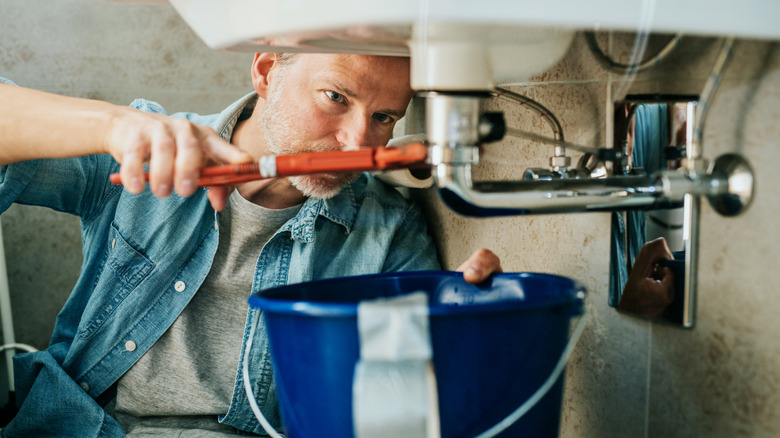The Correct Temperature To Set Your Thermostat At While You're On Vacation In The Winter
Slick roads, bad weather, and longer periods of darkness can all add to the challenges of winter travel. So can the constant worry of returning to a surprise energy bill or worse — a catastrophe of broken pipes from a cold snap or major winter storm while you were away from home. Whether you're heading to one of the most beautiful National Parks or need a beach escape in the dead of winter, make sure to set your thermostat to a constant temperature to keep your pipes from freezing before locking the front door. The "Goldilocks" temperature range is from 55 to 60 degrees, where anything lower than 55 degrees may lead to your pipes bursting, potentially costing thousands of dollars, and over 60 degrees means wasting money on energy bills.
Even when NOAA (the National Oceanic and Atmospheric Administration) and Weather.com predict a warmer-than-normal winter for much of the U.S., it is still a good idea to be prepared in case of a sudden cold snap like Winter Storm Uri brought Texas in 2021. If you know your pipes are not well insulated or live in an area with severe winter weather fluctuations, set the temperature a few degrees higher. Internal plumbing and pipes, such as those to a kitchen or bathroom sink, or in an attic or crawl space depend on your home's internal temperature to keep from freezing in the winter.
Although water freezes at 32 degrees Fahrenheit, pipes normally start to freeze when the temperature is below 20 degrees. Pipes can freeze up in six hours, but this depends on where the pipes are, how much insulation they have, the type of material the pipe is made from, and of course, the surrounding temperature. Generally, copper pipes are more prone to freezing than PEX, a polymer pipe.
How to prevent frozen pipes
The best way to prevent walking home to a mess is to prepare before you leave. Exposed and uninsulated pipes, such as those along the outside wall of a building, or in an attic are the most prone to freezing and often freeze at joints. When winterizing your home, the Red Cross recommends draining and cutting off water to all outdoor uninsulated pipes including those to pools, gardens, and hose bibs. Leave the outdoor taps open to let air flow as well as provide a way for excess water to get out of the system so they don't burst. Check the areas near piping around the outside of your home for gaps or air leaks, as small cracks can let in enough cold air to freeze an exposed pipe.
Other pipes prone to freezing should be protected and well-insulated; these include pipes in crawl spaces, attics, and basements. You can buy a very inexpensive foam sleeve online or from a local hardware store to place around a joint, or for a bigger surface area, heat tape will stop ice from forming inside. Be sure to follow the manufacturer's installation instructions, and when in doubt, call a professional.
To help protect your kitchen and bathroom pipes, open up the shower doors and the cupboards below to help warmer air reach bends and joints. You can also leave the faucet on at a very low trickle to provide a path for liquid water to leave so it doesn't freeze and cause pressure to build up in your home's plumbing system. If you will be away for a long time, it would be a good idea to winterize your home, including blowing out all of the water in the plumbing system and adding antifreeze (the non-toxic pink one) to toilets and sinks.
Signs of frozen pipes
If you come home to a bulging, frosty pipe, or turn on a sink and water is slowly trickling out, the water line may have frozen. If you suspect a pipe has frozen, the first thing you should do is turn off the main water line in your home. Not doing so may cause your home to be flooded, as the layer of ice is stopping water from flowing out of the burst pipe. Once you turn off the water, if possible, visually check the pipe, look for cracks, and touch it with your bare hands. Have a bucket and mop ready to clean up any water, as time is of the essence to prevent a bigger mess in your home. And, if you suspect the pipe has burst, call a plumber and your homeowner's insurance right away.
If the pipe hasn't burst, cut off water flow to the area, and open a valve to relieve pressure on the pipe. Then, use a small source of heat (hair dryer, small space heater) to slowly melt the ice inside of the pipe. Slow is key, as an abrupt temperature change could cause the pipe to crack. Also, don't use an open flame to melt the pipe as it could cause a fire or a pipe burst.
For peace of mind, it may be worth purchasing a smart thermostat integrated into your phone to have an up-to-the-moment idea of what's going on in your home. On top of using technology, it's always a good idea to tell a trusted friend or family member living nearby about your trip and have them check up on your house while you are away. Just don't forget one of the coolest souvenirs to say thanks for their help.


